Mission Statement:
We provide the best possible statewide transportation system
for the movement of people and goods.
Director's Office | Divisions & Districts | Aeronautics Commission | State Highway Commission
Careers | History of NDOT | Policymaker's Guide
Eight Strategic Goals
- Safety
- Fiscal Responsibility
- Environmental Stewardship
- Project Delivery
- Asset Management
- Mobility
- Communication, Coordination, Collaboration, & Cooperation
- Workforce Development
About NDOT
The Nebraska Department of Transportation (NDOT) is responsible for the planning, development, design, construction, maintenance and administration of the state highway system. The goals of the Department are to preserve the billions of dollars Nebraskans have invested in their state highway system, making the highways safe and efficient, and accomplishing this in a timely and cost-effective manner.
NDOT oversees and maintains an infrastructure network that includes:
- nearly 10,000 miles of public roads
- more than 3,500 bridges
- 599 buildings in 119 locations
- a fleet of over 2,100 cars, pickups, trucks and graders
The state highway system carries 63.5% of all vehicle miles traveled in the state. Municipal streets carry 25.6% and the county road network carries 10.9%. Also, about 83.7% of heavy truck travel in Nebraska is on the state highway system.
The Department uses a Pavement Management System to evaluate all state highway pavements. Each section of highway is inspected and rated annually based on smoothness and the amount of cracking, rutting or faulting. These ratings are used to determine the timing of projects and type of work necessary to keep the highway system in good repair. With pavement having a life span ranging from 15 to 30 years, the Department will have to resurface 500 miles per year to keep the highway system in good condition.
Budgeted expenditures per fiscal year are:
- Maintenance Program (patching, snow removal, striping, etc.) – approximately $150 million
- Construction Program (preservation/construction/reconstruction/resurfacing) – over $600 million
- Support Services & Administration – approximately $50 million
- Other Programs (public transportation assistance, rail planning, capital facilities, highway safety, and highway planning and research) – approximately $35 million
Nebraska’s state highway system is paid for totally by highway user taxes and fees. The three major sources of revenue are (1) motor fuel tax, (2) motor vehicle registrations and related fees, and (3) sales tax on motor vehicles, trailers and semi-trailers. Nebraska’s major highway user revenue is shared between the state, counties and cities.
Motor fuel receipts (numbers may vary slightly each year):
- 16.3¢ fixed tax effective 1/1/19 (9.5¢ to NDOT and 6.8¢ to cities and counties)
- 5% wholesale gasoline tax (66% to NDOT and 17% each to cities and counties)
- Variable fuel tax (100% percent to NDOT)
Motor vehicle registration fees and vehicle sales tax (53.3% to NDOT and 23.3% each to cities and counties).
The Build Nebraska Act (BNA), enacted in 2011, dedicated ¼ of one percent of sales tax receipts for expansion of the expressway system, federally designated high priority corridors, and preservation of the existing transportation system.
The Transportation Innovation Act (TIA), enacted in April 2016, provided NDOT with new revenue, programs and tools to increase mobility, freight, economic growth and safety in Nebraska. The purpose of TIA is to accelerate highway capital improvement, promote innovative solutions for deficient county bridges, and help finance transportation improvements that connect new and growing businesses.
There are 59 rural systems and nearly 90 organizations that provide specialized transportation for the elderly and disabled. In fiscal year 2017, the rural public transportation systems traveled nearly 3 million miles to transport passengers to medical appointments, employment, shopping, etc.
